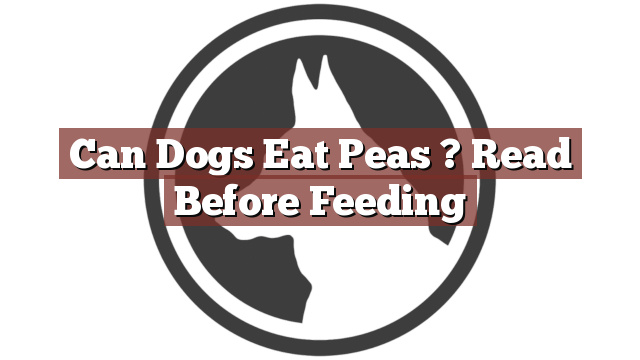Understanding Your Dog’s Dietary Needs
As a responsible dog owner, it is essential to understand your furry friend’s dietary needs. Dogs are omnivores, meaning they can consume a variety of foods, including both meat and plant-based options. While their primary source of nutrition should come from a balanced diet of high-quality dog food, it is natural to wonder about certain human foods and whether they can be safely incorporated into their diet. One common question that arises is, can dogs eat peas? Let’s delve into this topic to make an informed decision before feeding peas to your beloved pet.
Can Dogs Eat Peas? Read Before Feeding
Yes, dogs can eat peas. Peas are considered safe for dogs to consume and can be a healthy addition to their diet. These small green vegetables are packed with essential nutrients, including vitamins A, B, and K, as well as minerals like iron, potassium, and magnesium. Peas are also an excellent source of dietary fiber, which can aid in digestion and promote bowel regularity in dogs.
However, it is important to note that dogs have different dietary requirements than humans, and their digestive systems may not tolerate certain foods as well. Therefore, it is crucial to introduce peas gradually into your dog’s diet and monitor their response. Additionally, always consult with your veterinarian before making any significant changes to your dog’s diet, especially if they have pre-existing health conditions or dietary restrictions.
Pros and Cons of Feeding Peas to Dogs
Feeding peas to your canine companion can have several advantages. Firstly, peas are low in calories and fat, making them an ideal treat for dogs who need to shed a few pounds or maintain a healthy weight. The high fiber content in peas can also help your dog feel fuller for longer, reducing the chances of overeating.
Another benefit of peas is their rich antioxidant content. Antioxidants are essential for combating free radicals in the body, which can cause cell damage and lead to various health issues. By including peas in your dog’s diet, you can contribute to their overall well-being and potentially boost their immune system.
While peas have numerous benefits, some dogs may experience digestive issues when consuming them. As with any new food, it is crucial to introduce peas slowly and in small quantities to avoid any adverse reactions. Excessive consumption of peas may lead to gas, bloating, or even diarrhea in some dogs. It is essential to monitor your dog’s response and adjust their diet accordingly.
Conclusion: Considerations for Feeding Peas to Your Dog
In conclusion, dogs can safely eat peas as part of a balanced and varied diet. Peas offer several health benefits for your furry friend, including high fiber content, essential vitamins, and minerals. However, it is vital to introduce peas gradually to your dog’s diet, especially if they haven’t consumed them before. Monitor their response and consult with your veterinarian if you have any concerns or questions.
Remember, every dog is unique, and their dietary needs may vary. While peas can be a nutritious addition to your dog’s diet, it is crucial to consider their individual health, age, and any pre-existing conditions. By understanding your dog’s dietary needs and consulting with professionals, you can make informed decisions about their nutrition and ensure their well-being for years to come.
Thank you for taking the time to read through our exploration of [page_title]. As every dog lover knows, our furry friends have unique dietary needs and responses, often varying from one canine to another. This is why it's paramount to approach any changes in their diet with caution and knowledge.
Before introducing any new treats or making alterations to your dog's diet based on our insights, it's crucial to consult with a veterinarian about [page_title]. Their expertise ensures that the choices you make are well-suited to your particular pet's health and well-being.
Even seemingly harmless foods can sometimes lead to allergic reactions or digestive issues, which is why monitoring your dog after introducing any new food item is essential.
The content provided here on [page_title] is crafted with care, thorough research, and a genuine love for dogs. Nevertheless, it serves as a general guideline and should not be considered a substitute for professional veterinary advice.
Always prioritize the expert insights of your veterinarian, and remember that the health and happiness of your furry companion come first.
May your journey with your pet continue to be filled with joy, love, and safe culinary adventures. Happy reading, and even happier snacking for your canine friend!

